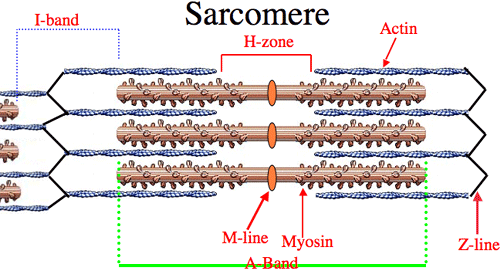The sliding filament model
A muscle is an example of an effectors and impulses are
transmitted by motor neurons which stimulate muscle cells to contract and
produce a response.
There are different types of muscles the first one is called
skeletal muscle it has a striated and striped appearance and can be attached to
bones via tendons. The type of contraction is voluntary and is very fast but is
short is in duration. The next is cardiac muscle it is also striated and is
used in the heart and has a involuntary contraction with a intermediate speed
and duration. The next type of muscle is smooth muscle and is non striated and
is used in the blood vessels and digestive system and is involuntary and is
slow and can be long lasting.
Muscle cells fuse to form fibers with each muscle fiber contains many myofibrils and are organelles made principally of having two
proteins called actin and myosin. The myofibrils are then composed of many
repeating units called sarcomeres.
A neuromuscular junction is the synapse between a motor neuron and a muscle fibre and it works
having the principles as a synapse between two neurons and a neurotransmitter
called acetylcholine this diffuses across the synaptic cleft and binds to
receptors on the sarcolemma which results in the depolarisation and a motor
unit comprises all the muscles fibres which is supplied by one motor neurone.
The sliding filament model process
1-The sarcolemma is depolarised
2-The depolarisation spreads through T-tubles to
sarcoplasmic reticulum a specialised smooth endoplasmic reticulum.
3-Calcium ions are released from sarcoplasmic reticulum.
4-Calcium ions binds to troponin which is a protein that is attached
to actin.
5-The troponin changes shape which causes tropomysoin to be moved
away from the myosin binding site it had been covering.
6-Myosin heads bind to the binding site on actin this forms cross
bridges.
7-Myosin heads tilt then moves the actin this is called the power
stroke and ADP is released from myosin at this stage.
8-ATP binds to mysoin causing it to detach from the actin.
9-ATP is hydrolysed to ADP causing the myosin head to resume
its original position the head is free to attach further down the actin and more
than 100 power strokes can be performed by each mysoin each second.
**REMEMBER TO STAY POSITIVE LIKE A PROTON!!**

No comments:
Post a Comment